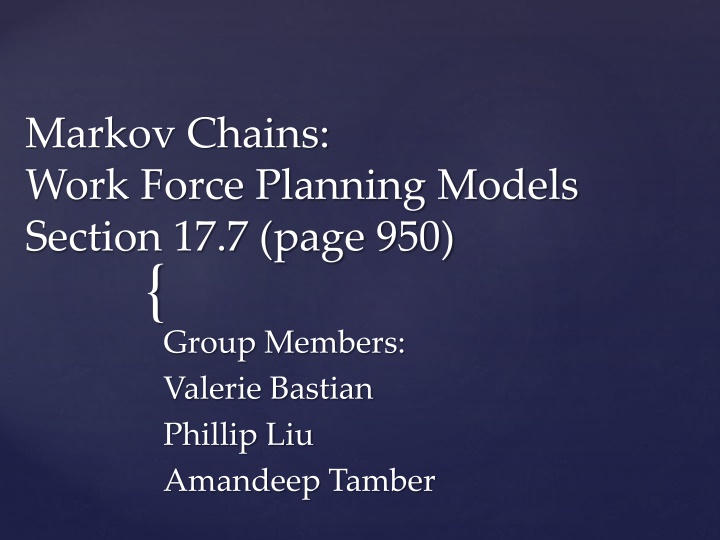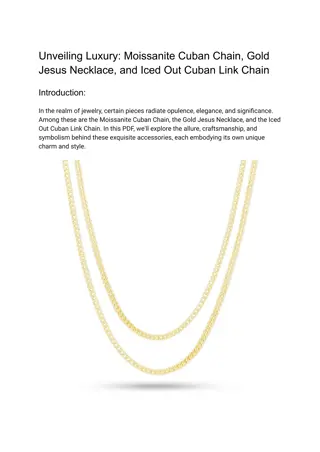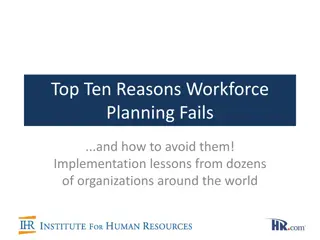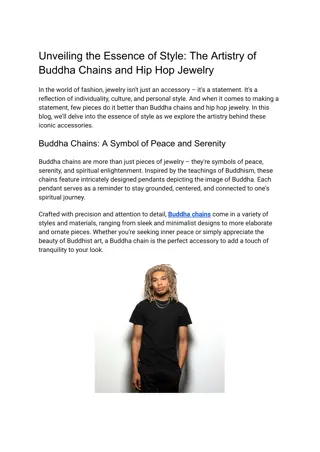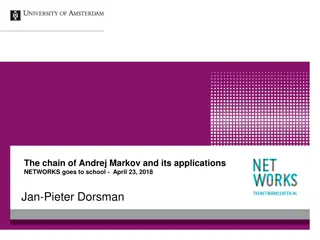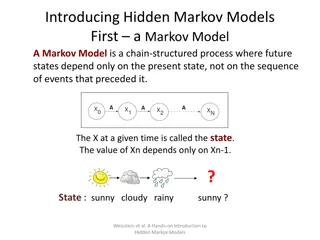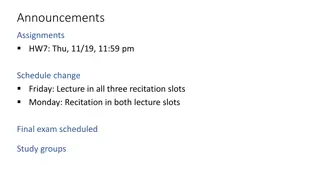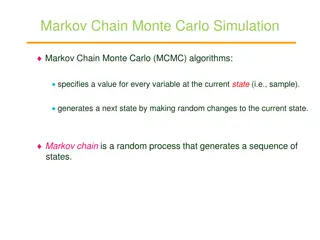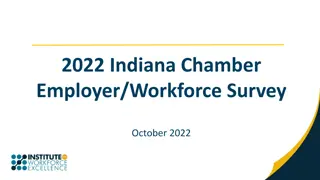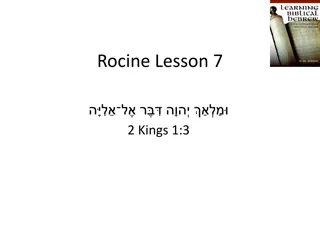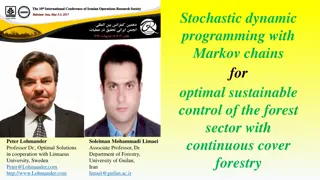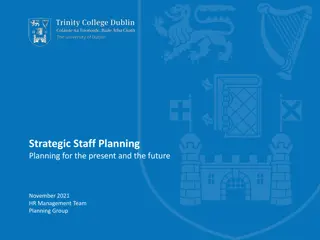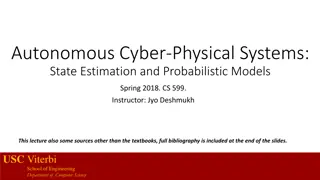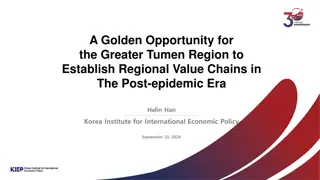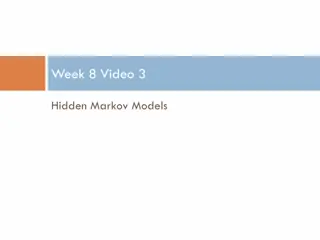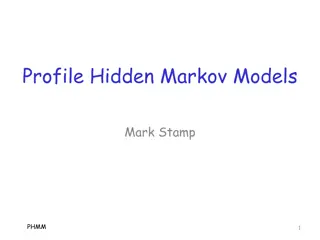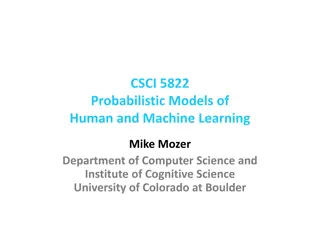Markov Chains: Workforce Planning Models Section 17.7
Delve into the intricate world of Markov Chains through the lens of workforce planning models in Section 17.7. Understand the dynamics of designing efficient workforce strategies with insights from group members Valerie Bastian, Phillip Liu, and Amandeep Tamber. Explore the applications of Markov Chains in optimizing staffing decisions and forecasting workforce trends. Discover the power of this mathematical tool in shaping organizational resource allocation and enhancing operational efficiency.
Download Presentation

Please find below an Image/Link to download the presentation.
The content on the website is provided AS IS for your information and personal use only. It may not be sold, licensed, or shared on other websites without obtaining consent from the author.If you encounter any issues during the download, it is possible that the publisher has removed the file from their server.
You are allowed to download the files provided on this website for personal or commercial use, subject to the condition that they are used lawfully. All files are the property of their respective owners.
The content on the website is provided AS IS for your information and personal use only. It may not be sold, licensed, or shared on other websites without obtaining consent from the author.
E N D
Presentation Transcript
Markov Chains: Work Force Planning Models Section 17.7 (page 950) { Group Members: Valerie Bastian Phillip Liu Amandeep Tamber
Work Force Planning Can help determine the number of employees of each type available in the steady state (long term future) Steady-State Probabilities vs. Steady-State Census
Textbook example 9, continued in the section problem 2 (pg 951) Consider the organization to have s groups America has 3 groups: Group 1: Children Group 2: Working adults Group 3: Retired There is also the s+1 group, the people who leave the organization Group 4: died
In this example, the children, working adult, and retired groups are transient states, because members can either remain in that group, or become a member of a different group (from one time period to the next) However, Those who have died are in an absorbing state because once they have entered that group, they will remain there forever
From one time period to the next, some people remain in the same group, some people enter a different group, and some people leave the organization. Use a s x (s+1) transition matrix to represent these fractions: 1 2 3 4 1 .959 .040 0 .001 2 0 .960 .030 .010 P= 3 0 0 .950 .050
It is traditional for an s x (s+1) transition matrix to be used for working force planning models; however it is also correct to also look at the transition matrix this way: T for a Transient State (group) A for an Absorbing State (group) T 1 2 T 1 .959 .040 T T 3 0 A 4 P= .001 T 2 0 .960 .030 .010 T 3 0 0 .970 .030 A 4 0 0 0 1
At the beginning of each time period: Hi = no. of new members to group i (from outside the organization) If positive, that group is hiring If negative, that group is firing For this problem, H1=1000 H2=0 H3=0 H4 does not apply, because group 4 is not within the organization
Keep in mind that Hi means those who enter the organization from outside the system. For example, the 1000 children who are born every year are not coming from any other pre-defined group. They are new members from outside the system. Once they are born, now they are within the organization (the system) because they are in group 1 (children).
Ni = no. of members in group i (during a steady state) As several time periods occur, (when t grows large). Each Ni will approach a limit, or All N reach the steady state census If each Ni approach a limit, it means the set of all N=(N1, N2, ..Ns) is the steady-state census of the organization
For this problem, N1= no. in group 1, in the steady state N2= no. in group 2, in the steady state N3= no. in group 3, in the steady state N4 does not apply, because group 4 is not within the organization and group 4 is an absorbing state, it will never reach a steady state census
Existence of Steady State Census The steady-state census exists if: The no. people entering each group is equal to the no. of people leaving each group (within the organization, groups 1 through s only). This can be expressed mathematically
Entering Leaving Hi+ (Nk*pki) = k i For all i=(1, 2, s) Ni* (pik) k i Hi = no. of new people who enter group i from outside the organization Ni= no. of people in group i (during a steady state) p=fraction of people from one group to the other
Children: 1,000 = (.04 +.001) N1 Working Adults: .04N1 = (.03+.01)N2 Retired: .03N2 = .05N3 Solution: N1= 24, 390 N2= 24, 390.24 N3= 14, 634.14 Solution means the steady state solution exists
Example 9 continues, given information: Each retired person receives a $5000 pension per year. The pension fund is funded by each working adult. How much money should each working adult contribute annually to the pension fund?
In the steady state: 14, 634.14 *($5000) = $73, 170, 700 needed for all retired people $73,170,700/ 24,390.24 = $3,000 that each working adult needs to contribute each year
Problem 2 (pg 953) have reduced the annual death rate for retired people from 5% to 3%. Suppose that advances in medical science annual pension contribution that a working adult would have to make to the pension fund? By how much would this increase the
P= 1 2 3 4 1 .959 .040 0 .001 P = 2 0 .960 .030 .010 3 0 0 .970 .030
Children: 1,000 = (.04 +.001) N1 Working Adults: .04N1 = (.03+.01)N2 Retired: .03N2 = .03N3 Solution: N1= 24, 390 N2= 24, 390.24 N3= 24, 390.24 Solution means the steady state solution exists
In the new steady state: 24, 390.24*($5000) = $121,951,219.5 needed for all retired people $ 121,951,219.5 / 24,390.24 = $5,000 that each working adult needs to contribute each year
Is this model a good representation of a population? not a good model for population, unless you consider a constant population. But for organizations, it is a good model because it shows how many should be hired/fired to stay in the steady state.
Even though the model is somewhat flawed in representing a population, the effect of changed death rate is a good one. We can also ask ourselves, what if we want to maintain a 3:1 ratio of working adults to retired people? How will this affect the amount each working adult needs to contribute? What does the birthrate need to be to provide this ratio?
If there are 3 working adults supporting the annual pension of one retired person $5000/3= $1, 666.67 Each working adult only needs to contribute $1,666.67 every year. What is the birthrate required to support this plan? Assume a population of 63, 414 (from original problem) and 50% population working
Desired Steady State Census: N2=3N3 N1+N2+N3=63,414 N2=(.5)*63,414 N2= 31,707 N3= 10, 569 N1= 21,138
Children: H1 = (.04 +.001) N1 Working Adults: .04N1 = (.03+.01)N2 Retired: .03N2 = .05N3 Solution: H1= 866.66 births/year
Summary Table Births per year % of population working $ each worker contributes per year Scenario 1 1,000 38% $3000 Scenario 2 866.66 50% $1667 Scenario 3 1,000 33% $5000
Problem 5 (pg 954) All State University Business School has faculty classified as tenured or untenured. Each year, 10% of the untenured faculty are granted tenure and 10% leave the university; 95% of tenured faculty remain, and 5% leave. The business school wants to maintain a faculty with 100 members, x% untenured. Determine a hiring policy to achieve this goal.
Assumptions Assume only the untenured can be hired/fired (for now) Assume that no tenured staff member later becomes untenured. Basically assume: H1= no. of hired, untenured H2= 0
Identify the groups We want to look at this problem like a work- force planning model, so we need s groups within the organization: Group 1: Untenured Staff Group 2: Tenured Staff S=2 Also, the s+1 group, outside the organization: Group 3: those who leave the university
Create the s x (s+1) matrix: 2 x 3 matrix 1 2 3 P= 1 .8 .1 .1 2 0 .95 .05
N1= no. untenured N2=no. tenured Desired Steady State Census: N1/100 =xN1+N2 = 100 ------------------------------- Untenured: H1 = (.1 +.1) N1 Tenured: (.1)N1 = (.05)N2
Solution: N1= 33.33 untenured staff N2= 66.67 tenured staff (so x= 33.33% untenured staff) H1=6.67 untenured people hired
For what values of x does this goal require firing tenured faculty members? 33.33% untenured staff means hiring 6.67 untenured every year Any x greater than 33.33% would mean firing tenured faculty each year (that is to stay at 100 staff)
Describe a hiring policy that maintains a faculty that is 10% untenured. Desired Steady State Census: N1/100 =xN1+N2 = 100 ------------------------------- X=10% untenured N1= 10 untenured members N2= 90 tenured members
Untenured: H1 = (.1 +.1)*10 Tenured: H2 + (.1)*10 = (.05)*90 H1 = 18 untenured should be hired H2 = 3.5 tenured should be hired This does not require tenured staff to be fired, because 10% < 33%
Describe a hiring policy that maintains a faculty that is 40% untenured. Desired Steady State Census: N1/100 =xN1+N2 = 100 ------------------------------- X=40% untenured N1= 40 untenured members N2= 60 tenured members
Untenured: H1 = (.1 +.1)*40 Tenured: H2 + (.1)*40 = (.05)*60 H1 = 12 untenured should be hired H2 = -1 tenured should be hired (one should be fired) This does require tenured staff to be fired, because 40% > 33%
Any questions on Work Force Planning Models? Thank you for listening
